Lyra constellation lies in the northern sky. It represents the lyre, a musical instrument with strings used in antiquity and later times.
The constellation is associated with the myth of the Greek musician and poet Orpheus. It was first catalogued by the astronomer Ptolemy in the 2nd century.
Lyra contains Vega, the fifth brightest star in the sky and second brightest star in the northern hemisphere, and the famous variable star RR Lyrae. It is also home to several notable deep sky objects, including the globular cluster Messier 56, the planetary nebula Messier 57 (the Ring Nebula), the merging triplet of galaxies NGC 6745, and the open cluster NGC 6791.
Facts, location and map
Lyra is a small constellation, 52nd in size, occupying an area of 286 square degrees. It is located in the fourth quadrant of the northern hemisphere (NQ4) and can be seen at latitudes between +90° and -40°. The neighboring constellations are Cygnus, Draco, Hercules and Vulpecula.
The constellation name Lyra is pronounced /ˈlaɪrə/. In English, the constellation is known as the Lyre. The genitive form of Lyra, used in star names, is Lyrae (pronunciation: /ˈlaɪriː/). The three-letter abbreviation, adopted by the International Astronomical Union (IAU) in 1922, is Lyr.
Lyra belongs to the Hercules family of constellations, along with Aquila, Ara, Centaurus, Corona Australis, Corvus, Crater, Crux, Cygnus, Hercules, Hydra, Lupus, Ophiuchus, Sagitta, Scutum, Sextans, Serpens, Triangulum Australe and Vulpecula.
The brightest star in the constellation is Vega, Alpha Lyrae, which is also the fifth brightest star in the sky, with an apparent magnitude of 0.03.
The constellation contains six formally named stars. The star names approved by the International Astronomical Union (IAU) are Aladfar, Sheliak, Sulafat, Vega, Xihe, and Chasoň.
Lyra contains two Messier objects – Messier 56 (M56, NGC 6779) and Messier 57 (M57, NGC 6720, Ring Nebula) – and has nine stars with known planets. There are three meteor showers associated with the constellation: the Lyrids, which peak around April 21-22 every year, the June Lyrids and the Alpha Lyrids.
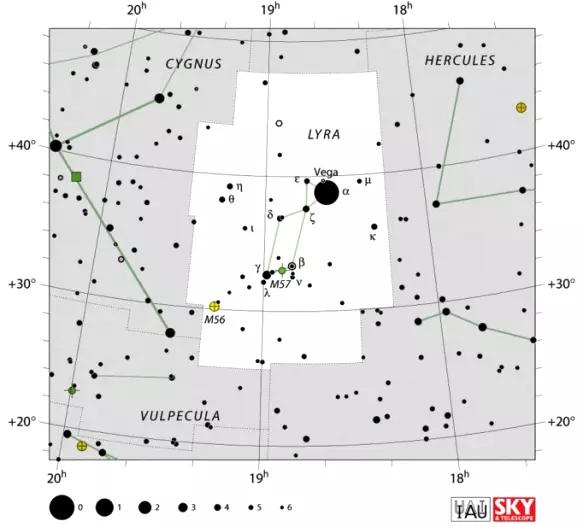
Lyra constellation map by IAU and Sky&Telescope magazine
Myth
Lyra represents the lyre of Orpheus, the musician and poet in Greek mythology who met his end at the hands of the Bacchantes. When he passed, his lyre was thrown into a river. Zeus sent an eagle to get the lyre and placed both of them in the sky.
Orpheus was the son of the Thracian King Oeagrus and the muse Calliope. When he was young, god Apollo gave him a golden lyre and taught him to play it, and his mother taught him to write verses.
Orpheus was known for his ability to charm even stones with his music, for his attempts to save his wife Eurydice from the underworld, and for being the harpist and companion of Jason and the Argonauts.
Without Orpheus and his music, the Argonauts would not have been able to make it past the Sirens, whose song enticed sailors to come to them, which usually resulted in sailors crashing their ships into the islands on which the Sirens lived. When the Argonauts approached the islands, Orpheus drew his lyre and played music that drowned out the Sirens’ calls.
The most famous story involving Orpheus is that of the passing of his wife Eurydice. Eurydice was trying to escape a satyr at her wedding, and fell into a nest of vipers. She was bitten on the heel. Orpheus found the body and, deeply shaken, he played songs that made the gods and the nymphs cry. The gods felt pity for him and advised him to travel to the underworld and try to retrieve Eurydice. Orpheus took their advice. Once there, his song deeply moved Hades and his wife Persephone and they agreed to return Eurydice to the world of the living on one condition: Orpheus should walk in front of her and not look back until they both had reached the upper world. Orpheus and Eurydice started walking and, as much as he wanted to, he did not look back. However, he forgot that they both had to arrive to the upper world before he could turn. As soon as he reached it, he turned around, but Eurydice was not quite there yet and she disappeared from his sight, for good this time.
Orpheus met his end at the hands of Thracian Maenads, who ripped him to shreds for not honouring Dionysus. His lyre was carried to heaven by the Muses, who also collected the fragments of his body and buried them below Mount Olympus.
Lyra constellation was often depicted as a vulture or an eagle carrying Orpheus’ lyre in its wings or beak, and called Aquila Cadens or Vultur Cadens, which means “the falling eagle” or “falling vulture.”
In Wales, the constellation is known as King Arthur’s Harp (Talyn Arthur) or King David’s Harp.
Lyra stars
Vega – α Lyrae (Alpha Lyrae)
Vega is the brightest star in the Lyra constellation. With an apparent magnitude of 0.03, it is also the fifth brightest star in the night sky, after Sirius in Canis Major, Canopus in Carina, Arcturus in Boötes, and Alpha Centauri A in Centaurus constellation. Vega is also the second brightest star in the northern sky; only Arcturus is brighter. The star is 25.04 light years distant from Earth.
Vega was the first star other than the Sun to be photographed and the first one to have its spectrum recorded. It was first imaged by William Bond and John Adams Whipple at the Harvard College Observatory on July 17, 1850, and it was the American amateur astronomer Henry Draper who took the first photograph of Vega’s spectrum in August 1872.
The star belongs to the spectral class A0V, which makes it a white dwarf. It was the northern pole star around the year 12,000 BC and will be again around the year 13,727.
Vega is 2.1 times as massive as the Sun, and only about a tenth of the Sun’s age. It is believed to be about 455 million years old, which is about a half of its life expectancy. It is a suspected variable star and a rapid rotator, with a projected rotational velocity of 274 km/s at the equator.
The star is believed to have a circumstellar disk of dust, as it emits excess infrared radiation. It may have at least one planet the size of Jupiter in its orbit.
Vega is easy to find in the night sky because it is bright and also because it is part of a familiar summer asterism, the Summer Triangle, which it forms with the stars Altair in the constellation Aquila and Deneb in Cygnus. Vega is located at the vertex of the triangle, and easy to find because the constellation Cygnus, the Swan, is easily recognizable in the sky.
Sulafat – γ Lyrae (Gamma Lyrae)
Gamma Lyrae is the second brightest star in the constellation. It has an apparent magnitude of 3.261 and is approximately 620 light years distant from the Sun. The star is a blue-white giant. It belongs to the spectral class B9 III.
Gamma Lyrae is sometimes known by its traditional names, Sulafat (Sulaphat) and Jugum. The name Sulafat is derived from the Arabic al-sulḥafāt, which means “the turtle,” and Jugum comes from the Latin word iugum, meaning “yoke.”
The star has a radius 15 times that of the Sun. It is a relatively fast rotator, with a projected rotational velocity of 71-72 km/s.
Sheliak –β Lyrae (Beta Lyrae)
Beta Lyrae is a double star system. It has an apparent magnitude of 3.52 and is approximately 960 light years distant from Earth. It has the traditional name Sheliak, derived from šiliyāq, which is the Arabic name for the constellation.
The Beta Lyrae system has a variable luminosity, ranging from 3.4 to 4.3 magnitudes. The variability was first discovered by the British astronomer John Goodricke in 1784. The components are so close together that they form a spectroscopic binary star, one that cannot be resolved into individual components with optical telescopes. The two orbit each other with a period of 12.9414 days and periodically eclipse each other. As a result, their apparent magnitude varies.
The primary star has the stellar classification of B7II – it is a blue-white bright giant. The secondary component is also believed to be a class B star.
The system is a semidetached binary, one in which one of the stars fills the binary star’s Roche lobe, and the other star does not. Gas from the surface of the donor star is transferred to the accreting star, and the transfer of mass dominates the system’s evolution. The B7II star, now the less massive component, was once the more massive component in the system. As is evolved into a giant, it transferred most of its mass to the other star, as the two are in close orbit. As a result, the other star is now surrounded by an accretion disk, one that makes it difficult to pinpoint the star’s exact stellar type.
R Lyrae
R Lyrae is a red giant with the stellar classification of M5III. It is a semiregular pulsating star with an apparent magnitude that varies between 3.9 and 5.0. The star is approximately 350 light years distant from the solar system. It is significantly brighter and larger, yet also cooler than the Sun.
δ Lyrae (Delta Lyrae)
Delta Lyrae consists of a star and a star system sharing the same Bayer designation.
Delta-1 Lyrae is a binary star system with an orbital period of about 88 days. The components have apparent magnitudes of 5.569 and 9.8. The separation between the two stars is very small and they form a spectroscopic binary. The system is approximately 1,100 light years distant from the Sun.
The primary star is a blue-white dwarf with the stellar classification of B2.5 V. It is twice as hot as the Sun and much brighter. The companion is an orange giant of the spectral type K2III, which makes it brighter and larger, yet cooler than the Sun.
Delta-2 Lyrae is a red bright giant with the stellar classification M4 II. It has an apparent magnitude of 4.30 and is approximately 740 light years distant. It is 6,500 times more luminous than the Sun and has a radius 200 times solar. The star is believed to be 75 million years old.
The Double Double – ε Lyrae (Epsilon Lyrae)
Epsilon Lyrae, popularly known as the Double Double, is a multiple star system about 162 light years away. It has an apparent magnitude of 4.7. In binoculars, the system appears as two stars, each of which can be resolved into a binary when observed through a telescope. The two main components, the binary stars, orbit each other.
Epsilon-1 Lyrae, the northern component in the system, is a double star consisting of components that are only 2.35 arc seconds apart. The stars have apparent magnitudes of 4.7 and 6.2 and an orbital period of about 1,200 years.
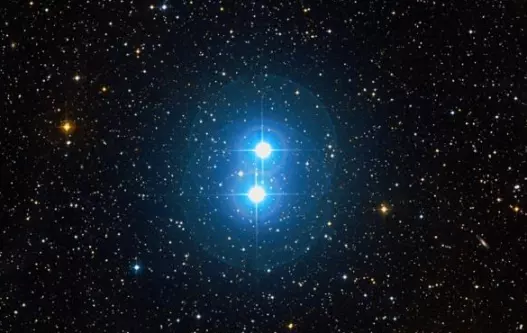
Epsilon Lyrae, image: Wikisky
The stars of Epsilon-2 Lyrae are separated by 2.3 arc seconds and have magnitudes of 5.1 and 5.5. Their orbital period is about half that of the Epsilon-1 stars.
Epsilon Lyrae has a fifth component, discovered in 1985. The star orbits the Epsilon-2 pair with an estimated period of a few decades.
RR Lyrae
RR Lyrae is a well-known variable star in Lyra constellation, located near the border with Cygnus. The star serves as a prototype of an entire class of stars, known as the RR Lyrae variables. These are periodic variable stars usually found in globular clusters and frequently used to measure galactic distances, as the relationship between their pulsation period and absolute magnitude makes them excellent standard candles.
RR Lyrae variables are pulsating horizontal branch stars belonging to the spectral class A (and much less frequently F), with about half the Sun’s mass. They are believed to have been similar to the Sun at some point, but then shed their mass. They are old, metal-poor stars with an average absolute magnitude of 0.75, and only 40 to 50 times more luminous than the Sun.
RR Lyrae is the brightest star in this class, with an apparent magnitude ranging from 7.06 to 8.12. The star has a mean apparent magnitude of 7.195 and is approximately 860 light years distant from the Sun.
RR Lyrae has evolved from the main sequence, passed through the red giant stage and is now in the horizontal branch (HB) stage of evolution, powered by helium fusion in its core and hydrogen fusion in the shell surrounding the core.
RR Lyrae’s variability was first discovered by the Scottish astronomer Williamina Fleming in 1901. The star shows a regular pattern of pulsation over a short period of 0.56686776 days, or 13 hours and 36 minutes. Each such radial pulsation causes the star’s radius to vary from 5.1 to 5.6 times the solar radius.
DM Lyrae
DM Lyrae is a dwarf nova, a cataclysmic variable star composed of a close binary system in which one of the stars is a white dwarf that accretes matter from the companion star. As a result, the white dwarf is involved in periodic outbursts, presumably as a result of the instability in the accretion disk.
The primary component in the DM Lyrae system is of unknown type. The system usually has an apparent magnitude of 18, but during outbursts the magnitude reaches 13.6. Two such outbursts were observed in the last century, one in 1928 and another in July 1996. The most recent one, in 1996, was a very long and bright one, indicating that the star is a variable of the SU Ursae Majoris type, one that has super-outbursts in addition to normal outbursts.
κ Lyrae (Kappa Lyrae)
Kappa Lyrae is an orange giant with the stellar classification of K2III. It has an apparent magnitude of 4.323 and is approximately 238 light years distant from the solar system. It is classified as a variable star.
Alathfar – μ Lyrae (Mu Lyrae)
Mu Lyrae is a white subgiant star belonging to the spectral class A3IVn. It has an apparent magnitude of 5.12 and is approximately 439 light years distant from Earth. The star’s traditional name, Alathfar (or Al Athfar), comes from the Arabic al-’uz̧fur, which means “the talons (of the swooping eagle.” It shares the name with Eta Lyrae, but the latter is usually spelled Aladfar.
Mu Lyrae lies 2.5 degrees west-northwest of Vega.
Gliese 758
Gliese 758 is a yellow dwarf with the stellar classification of G8V. It has an apparent magnitude of 6.36 and is 51.4 light years distant from the Sun. It can easily be seen in binoculars.
The star is similar to the Sun. It has 97 percent of the Sun’s mass, and 51 percent higher metallicity, i.e. abundance of elements other than hydrogen and helium.
A substellar companion, Gliese 758 b, was discovered in the star’s orbit in November 2009. It has between 30 and 40 Jupiter masses.
Kuiper 90 (17 Lyrae C, Gliese 747AB)
Gliese 747AB is a nearby star system composed of two red dwarf stars of the spectral types M3 and M5. The system is 26.5 light years distant from the Sun. The two stars orbit each other at a small angular separation (0.35”) with a period of 5 years.
Deep sky objects in Lyra
Messier 56 (M56, NGC 6779)
Messier 56 is a globular cluster in Lyra constellation. It has an apparent magnitude of 8.3 and is approximately 32,900 light years distant from the solar system. The cluster is about 84 light years across. It was discovered by Charles Messier on January 19, 1779.
M56 lies halfway between the stars Albireo (Beta Cygni) in Cygnus constellation and Sulafat, Gamma Lyrae. It appears as a fuzzy star in larger binoculars, but can be resolved with an 8 inch telescope.
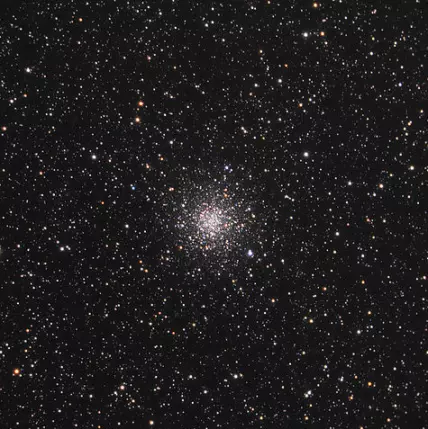
Messier 56, image: Wikimedia Commons/ Hewholooks (CC BY-SA 3.0)
M56 is believed to be about 13.70 billion years old. The brightest stars in it are 13th magnitude, and it contains about a dozen variables.
Ring Nebula – Messier 57 (M57, NGC 6720)
The Ring Nebula, Messier 57, is a famous planetary nebula in Lyra constellation, located south of the bright star Vega, about 40% of the distance from Beta to Gamma Lyrae. It is relatively easy to find and is a popular target among amateur astronomers.
The nebula was formed when a shell of ionized gas was expelled by a red giant star that was in the process of becoming a white dwarf. It is expanding at the rate of about 1 arc second per century. The central planetary nebula nucleus (PNN) was discovered by the Hungarian astronomer Jenő Gothard on September 1, 1886.
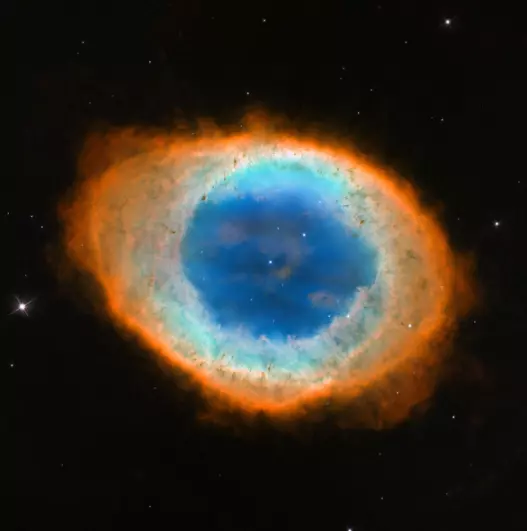
This image shows the dramatic shape and colour of the Ring Nebula, otherwise known as Messier 57. From Earth’s perspective, the nebula looks like a simple elliptical shape with a shaggy boundary. However, new observations combining existing ground-based data with new NASA/ESA Hubble Space Telescope data show that the nebula is shaped like a distorted doughnut. This doughnut has a rugby-ball-shaped region of lower-density material slotted into in its central “gap”, stretching towards and away from us. Image: NASA, ESA, and C. Robert O’Dell (Vanderbilt University)
The Ring Nebula belongs to the class of planetary nebulae known as bipolar nebulae. It has a thick equatorial ring that noticeably extends the structure through its main axis of symmetry.
The nebula has an apparent magnitude of 8.8 and is approximately 2,300 light years distant. It was discovered by the French astronomer Antoine Darquier de Pellepoix in January 1779, and Charles Messier discovered it independently later the same month, and included it in his catalogue as the 57th object.
NGC 6791
NGC 6791 is an open cluster in Lyra. It has an apparent magnitude of 9.5 and is approximately 13,30 light years distant from the solar system.
The cluster was discovered by the German astronomer Friedrich August Theodor Winnecke in 1853. It is believed to be around 8 billion years old. It is one of the oldest and most metal-rich clusters known in the Milky Way.
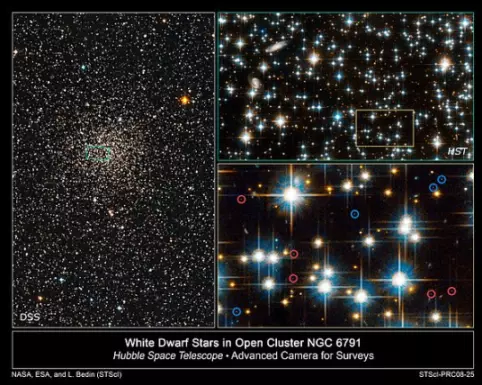
NGC 6791, image: NASA, ESA, Digitized Sky Survey, and L. Bedin (STScI)
NGC 6745
NGC 6745 is an irregular galaxy in Lyra constellation, believed to be around 10 billion years old. It has an apparent magnitude of 13.3 and is approximately 206 million light years distant from the Sun.
NGC 6745 is really a triplet of galaxies that have been colliding and merging for hundreds of millions of years. The larger galaxy, NGC 6745A, is believed to have been a spiral galaxy before the collision, but now appears peculiar as a result of the encounter.
The smaller galaxy, NGC 6745B, has passed through the larger one and is now moving away from it. The smaller galaxy is believed to have lost most of its interstellar medium to the larger one in the collision.
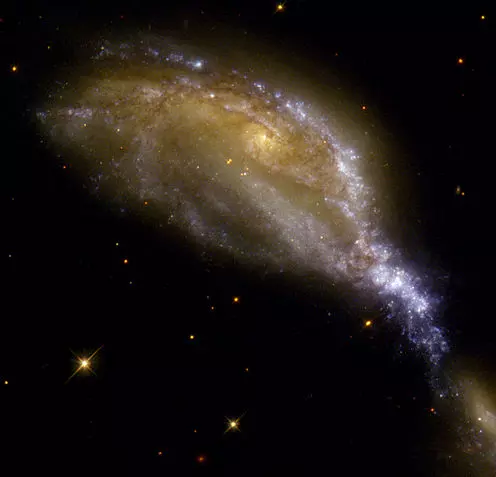
NGC 6745 – What appears as a bird’s head, leaning over to snatch up a tasty meal, is a striking example of a galaxy collision in NGC 6745. A large spiral galaxy, with its nucleus still intact, peers at the smaller passing galaxy (nearly out of the field of view at lower right), while a bright blue beak and bright whitish-blue top feathers show the distinct path taken during the smaller galaxy’s journey. These galaxies did not merely interact gravitationally as they passed one another, they actually collided. When galaxies collide, the stars that normally comprise the major portion of the luminous mass of each of the two galaxies will almost never collide with each other, but will pass rather freely between each other with little damage. This occurs because the physical size of individual stars is tiny compared to their typical separations, making the chance of physical encounter relatively small. In our own Milky Way galaxy, the space between our Sun and our nearest stellar neighbor, Proxima Centauri (part of the Alpha Centauri triple system), is a vast 4.3 light-years. However, the situation is quite different for the interstellar media in the above two galaxies – material consisting largely of clouds of atomic and molecular gases and of tiny particles of matter and dust, strongly coupled to the gas. Wherever the interstellar clouds of the two galaxies collide, they do not freely move past each other without interruption but, rather, suffer a damaging collision. High relative velocities cause ram pressures at the surface of contact between the interacting interstellar clouds. This pressure, in turn, produces material densities sufficiently extreme as to trigger star formation through gravitational collapse. The hot blue stars in this image are evidence of this star formation. This image was created by the Hubble Heritage Team using NASA Hubble Space Telescope archive data taken with the Wide Field Planetary Camera 2 in March 1996.
IC 1296
IC 1296 is a barred spiral galaxy in Lyra constellation. It has an apparent magnitude of 14.8 and is approximately 221 million light years distant from Earth.
The galaxy can be seen 4′ to the northwest of the Ring Nebula.